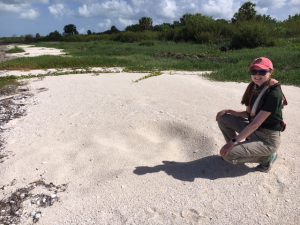By Katrina Rossos
“From camping under the stars, hiking through breathtaking canyons and vibrantly green forests, and catching salamanders, spiders, and other critters, I have grown up with a love for nature that can only be satisfied by pursuing a career in wildlife ecology,” Sidney McFarland said. Hailing from Celebration, Florida, McFarland, a University of Florida senior majoring in wildlife ecology and conservation, first began traveling to national parks with her parents from a young age. It was these experiences that opened her eyes to the beauty of natural landscapes and wildlife.

This past summer, McFarland served as an intern at Everglades National Park. She was a member of the BioCorps Internship program, which is a collaboration between the National Park Service, the South Florida National Parks Trust, and several agencies and university partners. McFarland first learned about the internship opportunity in Christina Romagosa’s Wildlife Colloquium. The idea of the BioCorps internship piqued her interest, so she decided to take Romagosa’s Everglades course in the spring and applied for the BioCorps program.
Working out of the Daniel Beard Center within Everglades National Park, McFarland’s official title was “shared intern”, and she was able to participate in a variety of field work and research projects. Yet, she mostly conducted sea turtle nesting surveys and invasive plant prevention in the hole-in-the-donut (HID) section of Everglades National Park.
“On days that I worked with sea turtles, we would scan an area of the beach, Cape Sable, for new nests and signs of hatching in older nests. Any nest 42 days or older was monitored until a bowl-shape depression was noticed, indicating hatching. Soon after, we would inventory the nest to count the number of hatchings and other incidents,” McFarland explained.

While doing the invasive plant work in the HID section of the park, McFarland sprayed herbicide on invasive or problematic native plant species, mostly cattail. “This was hot work but quite important for restoration goals in the area. The HID used to be overtaken by invasive Brazilian pepper until being scraped to the bedrock to allow regrowth of native Everglades species,” McFarland clarified.
In addition to these two tasks, McFarland conducted surveys for endangered butterflies in the Pine Rockland habitat. She also had the opportunity to trap invasive Argentine black and white tegus, set up microphones to capture audio of the Florida bonneted bat, and checked hydrology stations on the Gulf Coast.
Typically more knowledgeable about wildlife, McFarland’s eyes were open during this internship as she learned an enormous amount about plants and how detrimental certain invasive and non-native flora can negatively impact an ecological environment. However, the most rewarding experience that McFarland had during the internship was working with sea turtles, and now she would love to do more sea turtle work after she graduates.
One of the most memorable experiences that she had during the two-month internship occurred during sea turtle nesting surveys. McFarland was lucky enough to bring her father along while surveying, and they came upon a deceased, beached pilot whale on the shoreline. McFarland and another intern reported the sighting to dispatch and, although tragic, McFarland said she was excited to have the responsibility of reporting this discovery.

Before partaking in this summer internship, McFarland focused on environmental education with the goal of spreading her passion about the national parks to the youth. However, after participating in the BioCorps internship she thinks she may now be more interested in research and field work. The internship also gave McFarland the opportunity to learn about a variety of careers within the National Park Service including wildlife biologist and biotech positions. For now, she is pursuing both education and biology and said that if she does contribute to wildlife research in the future she would like to work with invasive species.
“I did a lot with invasive Argentine black and white tegus as well as Burmese pythons down in the Everglades, and I want to assist in research that mitigates these species and other invasives from protected areas,” she said.
No matter what road the future will take McFarland, the data entry and field work experience she had was indispensable and skillsets that will benefit her in the job search.
“I really pulled so much out of this internship and had experiences I will carry with me forever.”
 0
0
